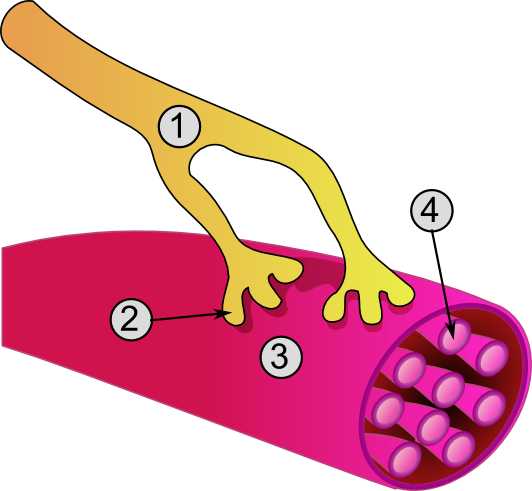|
Vecuronium
Vecuronium bromide, sold under the brand name Norcuron among others, is a medication used as part of general anesthesia to provide skeletal muscle relaxation during surgery or mechanical ventilation. It is also used to help with endotracheal intubation; however, agents such as suxamethonium (succinylcholine) or rocuronium are generally preferred if this needs to be done quickly. It is given by injection into a vein. Effects are greatest at about 4 minutes and last for up to an hour. Side effects may include low blood pressure and prolonged paralysis. Allergic reactions are rare. It is unclear if use in pregnancy is safe for the baby. Vecuronium is in the aminosteroid neuromuscular-blocker family of medications and is of the non-depolarizing type. It works by competitively blocking the action of acetylcholine on skeletal muscles. The effects may be reversed with sugammadex or a combination of neostigmine and glycopyrrolate. To minimize residual blockade, reversal ... [...More Info...] [...Related Items...] OR: [Wikipedia] [Google] [Baidu] |
Non-depolarizing
Neuromuscular-blocking drugs, or Neuromuscular blocking agents (NMBAs), block transmission at the neuromuscular junction, causing paralysis of the affected skeletal muscles. This is accomplished via their action on the post-synaptic acetylcholine (Nm) receptors. In clinical use, neuromuscular block is used adjunctively to anesthesia to produce paralysis, firstly to paralyze the vocal cords, and permit endotracheal intubation, and secondly to optimize the surgical field by inhibiting spontaneous ventilation, and causing relaxation of skeletal muscles. Because the appropriate dose of neuromuscular-blocking drug may paralyze muscles required for breathing (i.e., the diaphragm), mechanical ventilation should be available to maintain adequate respiration. This class of medications helps to reduce patient movement, breathing, or ventilator dyssynchrony and allows lower insufflation pressures during laparoscopy. It has several indications for use in the intense c ... [...More Info...] [...Related Items...] OR: [Wikipedia] [Google] [Baidu] |
WHO Model List Of Essential Medicines
The WHO Model List of Essential Medicines (aka Essential Medicines List or EML), published by the World Health Organization (WHO), contains the medications considered to be most effective and safe to meet the most important needs in a health system. The list is frequently used by countries to help develop their own local lists of essential medicines. , more than 155 countries have created national lists of essential medicines based on the World Health Organization's model list. This includes both Developed country, developed and Developing country, developing countries. The list is divided into core items and complementary items. The core items are deemed to be the most cost-effective options for key health problems and are usable with little additional health care resources. The complementary items either require additional infrastructure such as specially trained health care providers or diagnostic equipment or have a lower cost–benefit ratio. About 25% of items are in the ... [...More Info...] [...Related Items...] OR: [Wikipedia] [Google] [Baidu] |
Intravenous Therapy
Intravenous therapy (abbreviated as IV therapy) is a medical technique that administers fluids, medications and nutrients directly into a person's vein. The intravenous route of administration is commonly used for rehydration or to provide nutrients for those who cannot, or will not—due to reduced mental states or otherwise—consume food or water per os, by mouth. It may also be used to administer pharmaceutical drug, medications or other medical therapy such as blood transfusion, blood products or electrolytes to correct electrolyte imbalances. Attempts at providing intravenous therapy have been recorded as early as the 1400s, but the practice did not become widespread until the 1900s after the development of techniques for safe, effective use. The intravenous route is the fastest way to deliver medications and fluid replacement throughout the body as they are introduced directly into the circulatory system and thus quickly distributed. For this reason, the intravenous route ... [...More Info...] [...Related Items...] OR: [Wikipedia] [Google] [Baidu] |
Halothane
Halothane, sold under the brand name Fluothane among others, is a general anaesthetic. It can be used to induce or maintain anaesthesia. One of its benefits is that it does not increase the production of saliva, which can be particularly useful in those who are difficult to intubate. It is given by inhalation. Side effects include an Heart arrhythmia, irregular heartbeat, respiratory depression, and hepatotoxicity. Like all volatile anesthetics, it should not be used in people with a personal or family history of malignant hyperthermia. It appears to be safe in porphyria. It is unclear whether its usage during pregnancy is harmful to the fetus, and its use during a cesarean section, C-section is generally discouraged. Halothane is a Chirality (chemistry), chiral molecule that is used as a racemic mixture. Halothane was discovered in 1951. It was approved for medical use in the United States in 1958. It is on the WHO Model List of Essential Medicines, World Health Organization ... [...More Info...] [...Related Items...] OR: [Wikipedia] [Google] [Baidu] |
Isoflurane
Isoflurane, sold under the brand name Forane among others, is a halogenated ether used as a general anesthetic. It can be used to start or maintain anesthesia; however, other medications are often used to start anesthesia, due to airway irritation with isoflurane. Isoflurane is given via inhalation. Isoflurane was approved for medical use in the United States in 1979. It is on the World Health Organization's List of Essential Medicines. Medical uses Isoflurane is always administered in conjunction with air or pure oxygen. Often, nitrous oxide is also used. Although its physical properties imply that anaesthesia can be induced more rapidly than with halothane, its pungency can irritate the respiratory system, negating any possible advantage conferred by its physical properties. Thus, it is mostly used in general anesthesia as a maintenance agent after induction of general anesthesia with an intravenous agent such as thiopentone or propofol. Mechanism of action Similar to many ... [...More Info...] [...Related Items...] OR: [Wikipedia] [Google] [Baidu] |
Enflurane
Enflurane (2-chloro-1,1,2-trifluoroethyl difluoromethyl ether) is a halogenated ether. Developed by Ross Terrell in 1963, it was first used clinically in 1966. It was increasingly used for inhalational anesthesia during the 1970s and 1980s but is no longer in common use. Enflurane is a structural isomer of isoflurane. It vaporizes readily, but is a liquid at room temperature. Physical properties Pharmacology The exact mechanism of the action of general anaesthetics has not been delineated. Enflurane acts as a positive allosteric modulator of the GABAA, glycine, and 5-HT3 receptors, and as a negative allosteric modulator of the AMPA, kainate, and NMDA receptors, as well as of nicotinic acetylcholine receptors. Side effects Clinically, enflurane produces a dose-related depression of myocardial contractility with an associated decrease in myocardial oxygen consumption. Between 2% and 5% of the inhaled dose is oxidised in the liver, producing fluoride ions and difluoro ... [...More Info...] [...Related Items...] OR: [Wikipedia] [Google] [Baidu] |
Balanced Anesthesia
Balanced anesthesia, also known as multimodal anesthesia (also spelt: anaesthesia), is a technique used to induce and maintain anesthesia in patients undergoing surgery or certain medical procedures. This method employs a combination of anesthetic agents and other drugsand techniquesto selectively target various aspects of the central nervous system, allowing for a tailored anesthetic experience based on the individual patient's needs and the specific requirements of the procedure. The specialist physician (in Canadian and ; in Commonwealth and ) or veterinarian evaluates various patient factors prior to selecting an anesthetic approach. These factors include major organ function, general condition, and compensatory capacity (ability to function despite stressors). In balanced anesthesia, appropriate agents are used in combination, at carefully-calibrated levels. The concept of balanced anesthesia was first introduced by John Silas Lundy in 1926 and has since become the predomi ... [...More Info...] [...Related Items...] OR: [Wikipedia] [Google] [Baidu] |
Generic Medication
A generic drug is a pharmaceutical drug that contains the same chemical substance as a drug that was originally protected by chemical patents. Generic drugs are allowed for sale after the patents on the original drugs expire. Because the active chemical substance is the same, the medical profile of generics is equivalent in performance compared to their performance at the time when they were patented drugs. A generic drug has the same active pharmaceutical ingredient (API) as the original, but it may differ in some characteristics such as the manufacturing process, pharmaceutical formulation, formulation, excipients, color, taste, and packaging. Although they may not be associated with a particular company, generic drugs are usually subject to government regulations in the countries in which they are dispensed. They are labeled with the name of the manufacturer and a generic non-proprietary name such as the United States Adopted Name (USAN) or International nonproprietary name, Int ... [...More Info...] [...Related Items...] OR: [Wikipedia] [Google] [Baidu] |
Glycopyrrolate
Glycopyrronium bromide is a medication of the muscarinic anticholinergic group. It does not cross the blood–brain barrier and consequently has few to no central effects. It is given by mouth, via intravenous injection, on the skin, and via inhalation. It is a synthetic quaternary ammonium compound. The cation, which is the active moiety, is called glycopyrronium (INN) or glycopyrrolate ( USAN). The most common side effects include irritability, flushing, nasal congestion, reduced secretions in the airways, dry mouth, constipation, diarrhea, nausea and vomiting, and urinary retention. In September 2012, glycopyrronium was approved for medical use in the European Union. In June 2018, glycopyrronium was approved by the U.S. Food and Drug Administration (FDA) to treat excessive underarm sweating, becoming the first drug developed specifically to reduce excessive sweating. It is on the World Health Organization's List of Essential Medicines. Medical uses Glycopyrronium was firs ... [...More Info...] [...Related Items...] OR: [Wikipedia] [Google] [Baidu] |
Neostigmine
Neostigmine, sold under the brand name Bloxiverz, among others, is a medication used to treat myasthenia gravis, Ogilvie syndrome, and urinary retention without the presence of a blockage. It is also used in anaesthesia to end the effects of non-depolarising neuromuscular blocking medication. It is given by injection either into a vein, muscle, or under the skin. After injection effects are generally greatest within 30 minutes and last up to 4 hours. Common side effects include nausea, increased saliva, crampy abdominal pain, and slow heart rate. More severe side effects include low blood pressure, weakness, and allergic reactions. It is unclear if use in pregnancy is safe for the baby. Neostigmine is in the cholinergic family of medications. It works by blocking the action of acetylcholinesterase and therefore increases the levels of acetylcholine. Neostigmine was patented in 1931. It is on the World Health Organization's List of Essential Medicines. The term is from G ... [...More Info...] [...Related Items...] OR: [Wikipedia] [Google] [Baidu] |
Sugammadex
Sugammadex, sold under the brand name Bridion, is a medication for the reversal of neuromuscular blockade induced by rocuronium and vecuronium in general anaesthesia. It is the first selective relaxant binding agent (SRBA). It is marketed by Merck. The most common side effects include cough, airway problems due to the anaesthesia wearing off, reduced blood pressure and other complications such as changes in heart rate. Text was copied from this source which is copyright European Medicines Agency. Reproduction is authorized provided the source is acknowledged. Sugammadex is available as a generic medication. Medical uses Sugammadex is indicated for the reversal of neuromuscular blockade induced by rocuronium or vecuronium. Pharmacology Pharmacodynamics Sugammadex is a modified γ-cyclodextrin, with a lipophilic core and a hydrophilic periphery. This gamma cyclodextrin has been modified from its natural state by placing eight carboxyl thio ether groups at the sixth carbon po ... [...More Info...] [...Related Items...] OR: [Wikipedia] [Google] [Baidu] |




